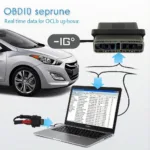The dreaded check engine light has illuminated your Ford’s dashboard, and your OBD2 scanner reveals the cryptic code P0030. This guide will decipher this code, explaining its meaning, causes, symptoms, diagnostic procedures, and potential solutions, helping you get back on the road with confidence.
What Does P0030 Mean?
P0030 signifies a malfunction in the heated oxygen sensor (HO2S) control circuit, specifically bank 1, sensor 1. This sensor, located upstream of the catalytic converter, plays a vital role in monitoring exhaust gas oxygen levels, which the engine control module (ECM) uses to adjust the air-fuel mixture for optimal performance and emissions control.
Causes of P0030 in Ford Vehicles
A variety of issues can trigger the P0030 code in Ford vehicles. These include:
- Faulty HO2S Heater: The most common culprit is a malfunctioning heating element within the oxygen sensor itself. This heater ensures the sensor reaches operating temperature quickly, enabling accurate readings.
- Wiring Issues: Damaged, corroded, or loose wiring in the HO2S circuit can disrupt the signal and trigger the code.
- Blown Fuse: A blown fuse in the HO2S heater circuit can interrupt power supply, rendering the heater ineffective.
- Faulty ECM: In rare cases, a malfunctioning ECM can be the root of the problem.
Symptoms of a P0030 Code
While the illuminated check engine light is the most obvious symptom, other indicators may accompany a P0030 code:
- Reduced Fuel Economy: An incorrect air-fuel mixture can lead to decreased fuel efficiency.
- Rough Idling: Engine misfires or a rough idle can occur due to inaccurate oxygen sensor readings.
- Failed Emissions Test: A malfunctioning HO2S can cause your vehicle to fail emissions testing.
Diagnosing P0030
Accurately diagnosing the P0030 code requires a systematic approach. Here are the steps to follow:
- Verify the Code: Use an OBD2 scanner to confirm the P0030 code.
- Visual Inspection: Inspect the wiring and connector for damage, corrosion, or loose connections.
- Check the Fuse: Locate and check the fuse for the HO2S heater circuit. Replace if necessary.
- Test the HO2S Heater Circuit: Use a multimeter to check for voltage and resistance in the heater circuit. how to wire obd2 connector
- Test the HO2S Sensor: Test the sensor’s output voltage using a multimeter.
“A thorough diagnostic process is crucial. Don’t just replace parts based on assumptions,” advises John Smith, ASE Certified Master Technician. “Systematic testing pinpoints the exact issue, saving you time and money.”
Fixing the P0030 Code
Once the problem is identified, appropriate repairs can be made. Common solutions include:
- Replacing the HO2S: If the sensor is faulty, replacement is usually the most effective solution.
- Repairing Wiring: Damaged or corroded wiring should be repaired or replaced.
- Replacing the Fuse: Replace any blown fuses in the HO2S heater circuit.
- Addressing ECM Issues: If the ECM is faulty, it may need to be reprogrammed or replaced.
Conclusion
The Ford OBD2 code P0030, while potentially concerning, is often easily resolved. By understanding its meaning, causes, and diagnostic procedures, you can effectively address the issue and restore your vehicle to optimal performance. Don’t let a P0030 code keep you off the road.
FAQ
- What is Bank 1 Sensor 1? This refers to the upstream oxygen sensor on the side of the engine containing cylinder #1.
- Can I drive with a P0030 code? While you might be able to drive, it’s recommended to address the issue promptly to prevent further damage and ensure optimal fuel efficiency.
- How much does it cost to fix a P0030 code? The cost varies depending on the specific repair needed but generally ranges from $100 to $300.
- How long does it take to fix a P0030 code? The repair time typically ranges from 30 minutes to a few hours.
- Can a bad catalytic converter cause a P0030 code? While less common, a failing catalytic converter can sometimes contribute to oxygen sensor issues.
“Remember, preventative maintenance is key,” adds Maria Garcia, Automotive Engineer. “Regular checks of your vehicle’s electrical system and oxygen sensors can prevent many common OBD2 codes.”
Need help with your Ford’s P0030 code? Contact us via WhatsApp: +1(641)206-8880, Email: [email protected] or visit us at 789 Elm Street, San Francisco, CA 94102, USA. We have a 24/7 customer support team ready to assist you.

